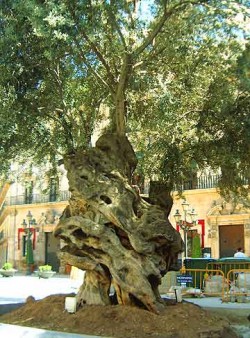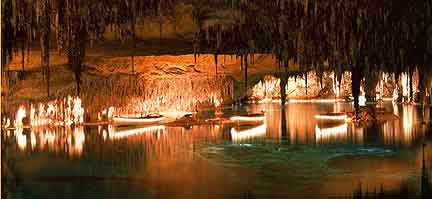
Lord and Lady Ball (yes, their real names), enjoyed a week in warm Palma de Mallorca, an annual retreat from the dreary London weather. They nimbly dodged the numerous pickpockets, flower sellers, and con artist that live in this paradise, supported by tourist dollars, pounds, euros, yen, etc. But their visit began with a fiasco.
On arrival at the Palma airport, they collected their luggage and piled it onto a cart. Then they pushed the cart out to their assigned rental car in the crowded lot. The way the cars were parked, they couldn’t get the cart close to the trunk of the car. So they left it in front of the car while they opened the doors and the trunk lid. When they turned back to the cart, it was gone. The whole thing was just gone.
Yes, I know. It sounds doubtful. You’d think they’d hear something, or at least see it being pushed off in the distance. But no.
Lady Ball gave a little shout and who should be nearby but a nice, friendly policeman! Just when you need him, right? Strangely, he didn’t have much of a reaction, but he directed the Balls to an airport police desk where they should report the stolen luggage.
So they did. And upon returning to their car, there was their stuff, next to a trash can in the parking lot. Everything of value was gone from inside. The Balls were left with a distinct feeling of fishiness.
They never discovered anything more about the incident. Neither did we.

Palma de Mallorca has long been a favorite holiday destination for Germans, Brits, and Swedes, and for Europeans in general. Many British retire to Mallorca, or have second homes there. Ferries bring daytrippers from mainland Spain, and cruise ships regularly dump sightseers by the thousands to bask in this balmy Spanish paradise. Its beaches and nightclubs are a perennial draw, and have been long before the spotlight hit Ibiza.
Low-lying criminals, too, are attracted to Palma’s easy-going lifestyle and laid-back law enforcement.
Bob and I have spent many a blistering summer day chasing thieves in Palma, a well-stocked laboratory for our research. We’ve been threatened there, and physically assaulted by thieves. Stories of these to come in future posts.
So I wondered: did Mallorca’s prevalent pickpockets plague every tourist attraction? Even underground? With that weak theory to prove, I had excuse enough to join the daytrippers on a journey to the Cuevas del Drach, or Caves of the Dragon, at Mallorca’s eastern coast. Well? If thieves can be nocturnal, why not subterranean? Leaving Bob on downtown surveillance, I set off by coach across the desolate landscape beyond the city of Palma.

The caves contain the largest underground lake in Europe, a superlative that failed to inspire my need-to-see instinct. So I paid for my ticket with minor lethargy and ambled off in the direction vaguely indicated, drawn to the cool, the dark, and the quiet.
A rough path descended gently into a forest of unfamiliar forms. Organic shapes and amoebic ponds in utter darkness were exquisitely lit to dramatic effect by an absolute (probably Italian) master. Disney couldn’t have done as well, and certainly couldn’t have created something so unreal, so otherworldly.
I got quite wet during the twenty-minute stroll into the depths. The surroundings first seemed inspired by Antoni Gaudi—or perhaps vice versa. Around me rose huge, undulating floor to ceiling columns in complicated bundles. Vast expanses of icicles by the millions pointed to curvaceous, humanoid formations below. I felt as if I were inside a giant pin cushion of some undefined shape. Or in the mouth of some great beast chewing taffy. Now, instead of Gaudi, I felt the influence of Dr. Suess. Among looming trunk-like forms the ceiling dripped and spattered and ploinked into puddles and pools. Stalactites and stalagmites were forming as I watched.
The uneven path wound down and around, along crystal clear ponds containing underwater figures—or were they reflections from above?—and eventually to an enormous gallery surrounded on three sides by a lake of such stillness and clarity it could have been air. A number of visitors had already gathered on the peninsula, settling onto wet benches facing Lago Martel and the thick and thin columns growing out of it.
Lights went out one by one and the crowd became silent. We were allowed a few moments to savor the cool void, the faintly clammy air, the crisp smell of absolutely fresh water, the surround-sound of erratic drips, and the unfortunate absence of bats.
Then, far, far in the distance, a violin. Chopin. The music grew, as did a faint glow from the depths of the cave. Finally, still distant, a curved row of fairy lights appeared, doubled by its reflection. It was a small boat encircled by a string of white lights, gliding smoothly as if on a rail. Another Disney effect. The boat carried a small orchestra and a single rower who dipped and pulled his oar like a slow metronome. Chopin became Offenbach as the boat drew near; the music swelled then filled and overflowed what had been a void, an unnoticed nothingness. Ghostly and surreal, the boat slid past us to hover in a small grotto, its single string of bulbs still the only illumination.
The concert ended as it had begun, with the simultaneous dwindling of music and light as the vessel and its orchestra sailed slowly, serenely, out of sight. As the last note sounded, a thunderous applause exploded in the darkness.
Gradually, stalagmites were randomly lit and the audience came out of its collective trance.
“Where’s my purse?” A woman’s panicked voice echoed nearby. I snapped my head around to look for her.
“Here,” said another, lifting dripping, waterlogged leather from the cave floor. I fought an urge to lecture the woman.
A line of rowboats had magically appeared. Visitors rose reluctantly to be ferried across the lake to a path leading up and out of the cave.
I emerged damp, blinking like Gollum, and drunk on the multisensual subterranean experience. While not exactly relevant research on the underground subculture we study, the venture below had been well above my expectations, and a fine respite.
![]()
